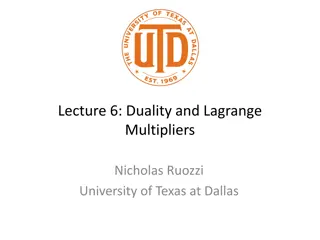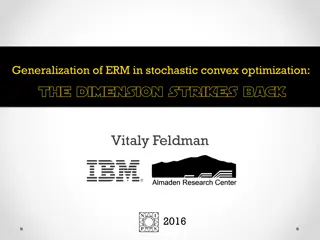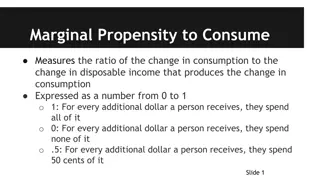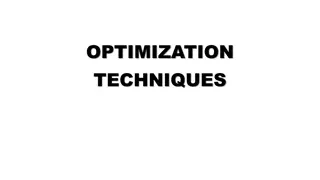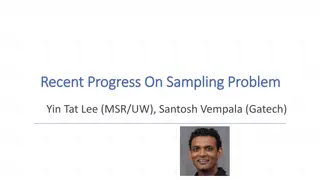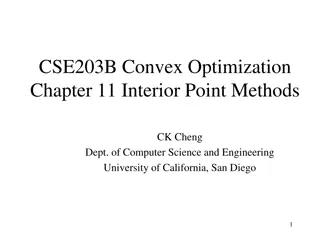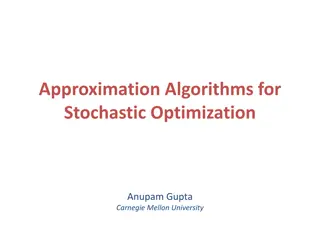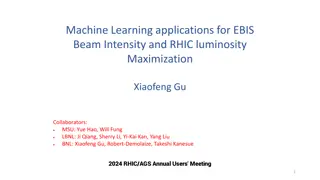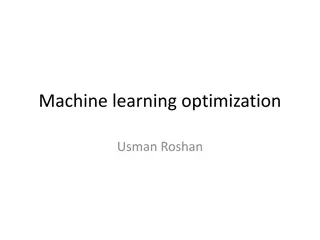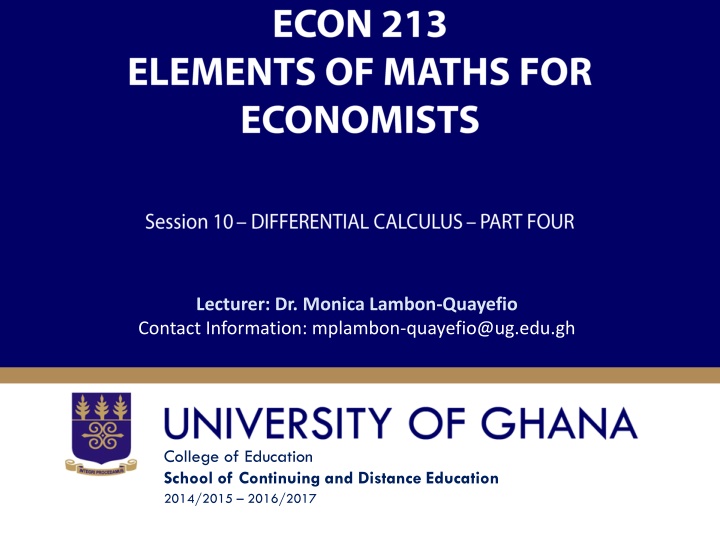
Constrained Optimization with Lagrange Multiplier in Economics
This session introduces students to constrained optimization using the Lagrange multiplier function, facilitating solving economic problems under constraints. Topics include setting up optimization problems, optimizing economic functions, and applications in economics. Reading list and detailed session outline provided.
Download Presentation

Please find below an Image/Link to download the presentation.
The content on the website is provided AS IS for your information and personal use only. It may not be sold, licensed, or shared on other websites without obtaining consent from the author. If you encounter any issues during the download, it is possible that the publisher has removed the file from their server.
You are allowed to download the files provided on this website for personal or commercial use, subject to the condition that they are used lawfully. All files are the property of their respective owners.
The content on the website is provided AS IS for your information and personal use only. It may not be sold, licensed, or shared on other websites without obtaining consent from the author.
E N D
Presentation Transcript
Lecturer: Dr. Monica Lambon-Quayefio Contact Information: mplambon-quayefio@ug.edu.gh College of Education School of Continuing and Distance Education 2014/2015 2016/2017
Session Overview Solutions to economic problems frequently have to be found under constraints (eg. maximizing utility subject to a budget constraint or minimizing costs subject to some requirement of output such as production quota).This session introduces students to constrained optimization using the Lagrange multiplier/function which greatly facilitates this task. The session also presents some applications of constrained optimization in economics using the Lagrangian multiplier. Objectives At the end of the session, the student will Be able to set up the constrained optimization problem using the Lagrangian multiplier Be able to optimize economic functions using constrained optimization approach. Slide 2
Session Outline The key topics to be covered in the session are as follows: Constrained Optimization using the Lagrangian Optimizing Economic Functions using constrained optimization. Slide 3
Reading List Sydsaeter, K. and P. Hammond, Essential Mathematics for Economic Analysis, 2nd Edition, Prentice Hall, 2006- Chapter 14 Dowling, E. T., Introduction to Mathematical Economics , 3rdEdition, Shaum s Outline Series, McGraw-Hill Inc., 2001.- Chapter 5 Chiang, A. C., Fundamental Methods of Mathematical Economics , McGraw Hill Book Co., New York, 1984.- Chapter 12 Slide 4
Topic One CONSTRAINED OPTIMIZATION USING LAGRANGE MULTIPLIER Slide 5
Constrained Optimization In the optimization process, the variables to be chosen may be required to satisfy certain constraints. For example, the quantities of goods demanded by a consumer may be subject to the available income level or his budget. The lagrange muItiplier method is used to solve optimization problems involving constraints. A constrained optimization problem is a problem of the form maximize (or minimize) the function f(x, y) subject to the condition g(x, y) = k ( a constant). Since the constraint involves an equal sign, the optimization problem is described as equality-constrained optimization. Slide 6
Constrained Optimization In a constrained optimization problem, a new function F can be formed by setting the constraint to zero, multiplying it by ( called the lagrange multiplier) and then adding the product to the original function : L(x,y, )= f(x,y)- [g(x,y)-c] L(x,y, ) is the Lagrangian function f(x,y) is the objective function g(x,y) is the constraint. Slide 7
The Lagrange Multiplier There are other techniques of solving constrained optimization problems. However, this method is often used by economists because the lagrange multipliers have an important economic interpretation. The lagrange multiplier approximates the marginal impact on the objective function caused by a small change in the constant of the constraint. For example, if =2, it implies that a 1-unit increase/decrease in constant of the constraint would cause the objective function to increase/decrease by 2 units. In utility maximization subject to a budget constraint for example, will estimate the marginal utility of an extra dollar of income. Lagrange multipliers are also referred to as shadow prices. Slide 8
The Lagrange Multiplier Method To maximize or minimize f(x,y) subject to g(x,y)=k, Follow the steps below: Write down the Lagrangian Function: 1. L(x,y)= f(x,y)- (g(x,y)-k) is a constant 2. Differentiate L w.r.t x, y and . and equate the partial derivatives to 0. These are called the first order conditions. 3. The equations from the first order conditions above and the constraint yield the following three equations: ?1 (x,y)= ?1 ?2 (x,y)=?2 g(x,y)=k (x,y)- ?1 (x,y) =0 (x,y)- ?2 (x,y) =0 4. Now solve these equations simultaneously for the three unknowns.
Example1: Constrained Optimization Optimize the function Z= 4?2+3xy+6?2 subject to the constraint x +y =56. Solution: Lagrangian Function: L(x,y, ) = 4?2+3xy+6?2- (x+y-56) First order conditions: ??(x,y, )= 8x+3y- = 0 (1) ??(x,y, )=3x+12y- = 0 (2) x+y=56 (3)
Example1: Constrained Optimization Subtract (2) from (1) to get: 5x-9y=0 => x=1.8y substitute x=1.8y into (3) to get y=20. This implies: x=36 and y=20 and = 348. Substituting the values of x,y into the objective function gives z= 9744.
Example 2: Use the Lagrangian multiplier to optimize the following function subject to the given constraint, and estimate the effect on the value of the objective function from a 1-unit change in the constant of the constraint. Z=4?2-2xy+6?2 subject to x+y=72 Solution: L(x,y, )=4?2-2xy+6?2- (x+y-72) First order conditions: ??= 8x-2y- =0 (1) ??= -2x+12y- =0 (2) x+y=72 (3)
Example 2: Solving for x and y: Subtract (2) from (1) to obtain: 10x-14y=0 Now put (4) into (3) 1.4y+y=72 y=30 x=1.4(30)=42 The critical values are therefore: x=42 and y=30. x= 1.4y (4) Substitute the critical values into (1) : 8(42)-2(30)= = 276 Also substituting the critical values into the objective function yields: z=9936.
Example 2: Interpreting : With =276, a 1-unit increase in the constant of the constraint will lead to an increase of approximately 276 in the value of the objective function. The objective function will therefore increase in value from 9936 to 10,212.
Trial Questions Use the Lagrangian multiplier to optimize the following functions subject to the given constraint, and estimate the effect on the value of the objective function from a 1-unit change in the constant of the constraint. 1. 26x-3?2+5xy-6?2+12y subject to 3x+y=170 2. 4xy?2 subject to x+y+z=56 3. 4?2-3x+5xy-8y+2?2 subject to x=2y
Topic Two CONSTRAINED OPTIMIZATION OF ECONOMIC FUNCTIONS Slide 16
Optimizing Economic Functions Solutions to economic problems frequently have to be found under constraints. Examples include: Maximizing utility subject to a budget constraint Minimizing costs subject to some minimal requirement of output et. The use of the Lagrangian function greatly facilitates the process of optimizing such objective functions in the face of their respective constraints. 17
Example 1: Cost Minimization Find the critical values for minimizing the costs of a firm producing two goods x and y when the total cost function is given as C= 8?2- xy+12?2 and the firm is bound by contract to produce a minimum combination of goods totaling 42 that is , subject to the constraint x+y=42. Solution: Setting the Lagrangian function: L(x,y, )= 8?2-xy+12?2- (x+y-42) First order conditions: ??= 16x-y- =0 ??= -x+24y- =0 x+y=42 Slide 18
Example 1 Solving the three system of equations simultaneously, we obtain the following values: x=25, y=17 and =383. Interpretation of : a 1-unit increase in the constraint or production quota will lead to an increase in the cost of approximately $383. * You can check the nature of the critical values by using the second order conditions for a minimization from the previous sessions. Slide 19
Example 2: Profit Maximization A monopolistic firm has the following demand functions for each of its products x and y given as: x=72-0.5?? and y= 120- ??. The combined cost function is c=?2+xy+?2+35 and the maximum joint production is 40. Therefore the production constraint is x+y=40. Find the profit-maximizing level of output, price and profit. Solution: x= 72-0.5?? => ??= 144-2x Y=120-?? ??= 120-y Profit (?)= TR-TC where TR=price x quantity => ?? . ? + ??. ? =(144-2x)x+(120-y)y (?)= (144-2x)x+(120-y)y- (?2+xy+?2+35) Slide 20
Example 2 The Lagrange Function: L(x,y, )= 144x-3?2-xy-2?2+120y-35- (x+y-40) First order conditions: ??= 144-6x-y- =0 ??= -x-4y+120- =0 x+y=40 Solving the system of equations simultaneously yields: x=18, y=22 and =14 Substituting x and y into ??and ??gives: ??=108 and ??=98 and ? = 2861 Slide 21
Example 3: Utility Maximization Maximize utility u=?1?2 when ?1 =1 and ?2=4 and one s budget B is 120. Estimate a 1-unit increase in the budget. Solution: The constraint can be written as: ?1?1+?2?2= B Substituting for the values above, the budget constraint is: ?1+4?2= 120 The Lagrange function: L(?1,?2, )=?1?2- (?1+4?2-120)
Example 3 Contd. First Order Conditions: ??1= ?2- =0 => ?2= ??2= ?1- 4 =0 ?1+4?2= 120 Solving the system of equations simultaneously yields: ?1= 60 ?2=15 and =15 With =15, a unit increase of the budget constraint from 120 to 121 will lead to an increase in the utility function by approximately 15.
Example 4: Cobb Douglas Functions Economic analysis usually makes use of the Cobb-Douglas production function written as : q= A???? where A>0, 0<?,? <1. where q is the quantity of output in physical units, K is the quantity of capital and L is the quantity of labour. ?, the output elasticity of capital measures the percentage change in output as a result of a percentage change in K while L is held constant. ?, the output elasticity of labour measures the percentage change in output as a result of a percentage change in labour while K is held constant. A is and efficiency parameter which reflects the level of technology being applied in the production process.
Examples Optimize the Cobb-Douglas production function q= ?0.3?0.5 subject to 6K+2L=384. Solution: The Lagrangian Function: L(K,L, )= ?0.3?0.5- (6K+2L-384) First order conditions: hint: apply the power rule of differentiation ??= 0.3? 0.7?0.5-6 =0 (1) ??= 0.5?0.3? 0.5-2 =0 (2) 6K+2L=384 (3)
Examples Rearrange and divide (1) by (2) to eliminate : 0.3? 0.7?0.5 0.5?0.3? 0.5=6 2 0.6? 1?1=3 => ? Now substituting L=5K into (3) 6K+2L=384 => 6K+2(5K)= 384 => 6K+10K=384 16K=384 => K=24 and L=5(24)=120. K=24 and L=120 3 ?= 0.6 => L=5K
Trial Questions Maximize the following utility functions subject to the given budget constraints. 1. u=?0.6?0.25 given ??=8, ??=5 and B=680 2. u=?0.8?0.2 given ??=5, ??=3 and B=75 Slide 27




